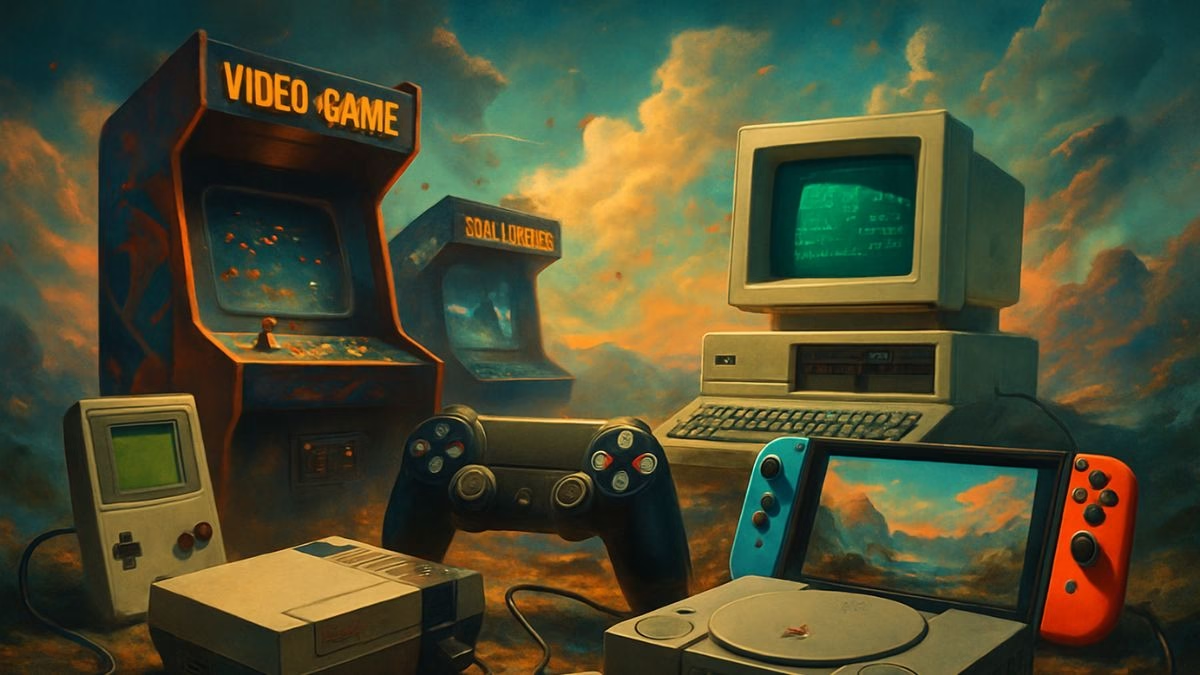Introduction
Have you ever wondered where video games came from? Before the stunning, massive worlds of today’s blockbusters, there were simple dots of light on a screen, clunky plastic consoles, and noisy arcades that smelled of popcorn and pizza. The journey from there to here is one of the most exciting and fast-paced stories in modern history. This isn’t just a test of your knowledge; it’s a time machine. Each question will transport you to a different era, challenging you to uncover the key moments, the groundbreaking inventions, and the iconic games that leveled up our world. By the end, you’ll have a new appreciation for the pixels and processors that power your favorite pastime. So, grab your controller, press start, and let’s begin the adventure!
Learning Quiz
This is a learning quiz from English Plus Podcast, in which, you will be able to learn from your mistakes as much as you will learn from the answers you get right because we have added feedback for every single option in the quiz, and to help you choose the right answer if you’re not sure, there are also hints for every single option for every question. So, there’s learning all around this quiz, you can hardly call it quiz anymore! It’s a learning quiz from English Plus Podcast.
Quiz Takeaways | From Pixels to Power-Ups – The Epic Story of Video Games
Hello and welcome to a story of imagination, innovation, and a whole lot of fun. Today, we’re going on a quest to understand the evolution of video games. It’s a journey that starts in a science lab with a simple dot of light and ends in the vast, interconnected virtual worlds that millions of people inhabit every day. It’s a story about how technology and creativity came together to create an entirely new form of art and entertainment.
Our journey begins not in a teenager’s bedroom, but in a laboratory. In 1958, a physicist named William Higinbotham created “Tennis for Two” on an oscilloscope to liven up a public exhibition. This simple tennis simulation was arguably the first video game, a novelty for a handful of people. The idea of playing games on a screen at home was pure science fiction until 1972, with the arrival of the Magnavox Odyssey. This was the world’s first home console, a primitive device that let families play simple paddle-and-ball games on their televisions.
But the real spark that lit the fuse of the video game industry happened in the arcades. A company called Atari released a game called “Pong,” and the world was never the same. The success of “Pong” led to an arcade boom. Soon, arcades were filled with the sounds of games like “Space Invaders,” where players blasted rows of descending aliens, and “Pac-Man,” a game about a little yellow circle that became the world’s first video game superstar.
The success of the arcades quickly moved into the home with the Atari 2600 console. But this success was a double-edged sword. The market became flooded with consoles and a deluge of low-quality, rushed games. The most infamous of these was “E.T. the Extra-Terrestrial,” a game so bad it has become legendary. Consumers lost faith, and the industry crashed hard in what we now call the Video Game Crash of 1983. Many thought video games were just a passing fad.
But they were wrong. A Japanese playing card company named Nintendo had other ideas. In 1985, they brought their Nintendo Entertainment System, or NES, to North America. Bundled with the groundbreaking game “Super Mario Bros.,” the NES was a phenomenon. Its high quality and incredible games single-handedly revived the industry and made Nintendo a household name. This kicked off a new era of competition, the famous “Console Wars” of the 1990s, where Nintendo and its mascot Mario faced a fierce rival: Sega, and their speedy blue hero, Sonic the Hedgehog.
The mid-90s brought the next great leap: the jump from 2D to 3D. Consoles like the Sony PlayStation and the Nintendo 64 introduced worlds with depth and dimension. The N64’s controller, with its revolutionary analog stick, gave us a new, intuitive way to move through these 3D spaces, setting the standard for every controller that followed.
As the internet became more widespread, so did online gaming. Microsoft’s Xbox console and its Xbox Live service, launched in 2002, made it easy for console players to connect and compete with friends across the globe, turning multiplayer gaming into a mainstream activity. Not long after, Nintendo changed the game again with the Wii in 2006. Its innovative motion controls got players off the couch and physically swinging, bowling, and playing, attracting a massive new audience of casual players.
The 21st century also saw the rise of a new kind of developer. No longer did you need a massive publisher to make a game. Digital distribution allowed small, independent teams to create and sell their own games. This “indie” movement gave us some of the most creative and successful games ever made, most notably “Minecraft,” a game about building and survival that became a global cultural force. At the same time, the rise of the smartphone created a whole new frontier, with simple but addictive games like “Angry Birds” reaching billions of people.
Today, the evolution continues at a breakneck pace. Modern games are supported long after their release with official updates called “patches” to fix bugs, and are expanded with “DLC,” or downloadable content. The business has changed, too, with free-to-play games being supported by players buying “cosmetic items” to personalize their characters. And we’re looking towards a future of incredible immersion with Virtual Reality (VR) headsets that place us directly inside the game world.
The evolution of video games is more than just a story about technology getting better. It’s a story about art. It’s about how simple pixels on a screen can evolve into complex “campaigns” that tell powerful stories. It’s about how a simple idea can connect millions of people in a shared, virtual space. From “Tennis for Two” to today’s global blockbusters, the goal has always been the same: to spark our imagination, to challenge our skills, and to let us, for a little while, be the hero of the story.










0 Comments